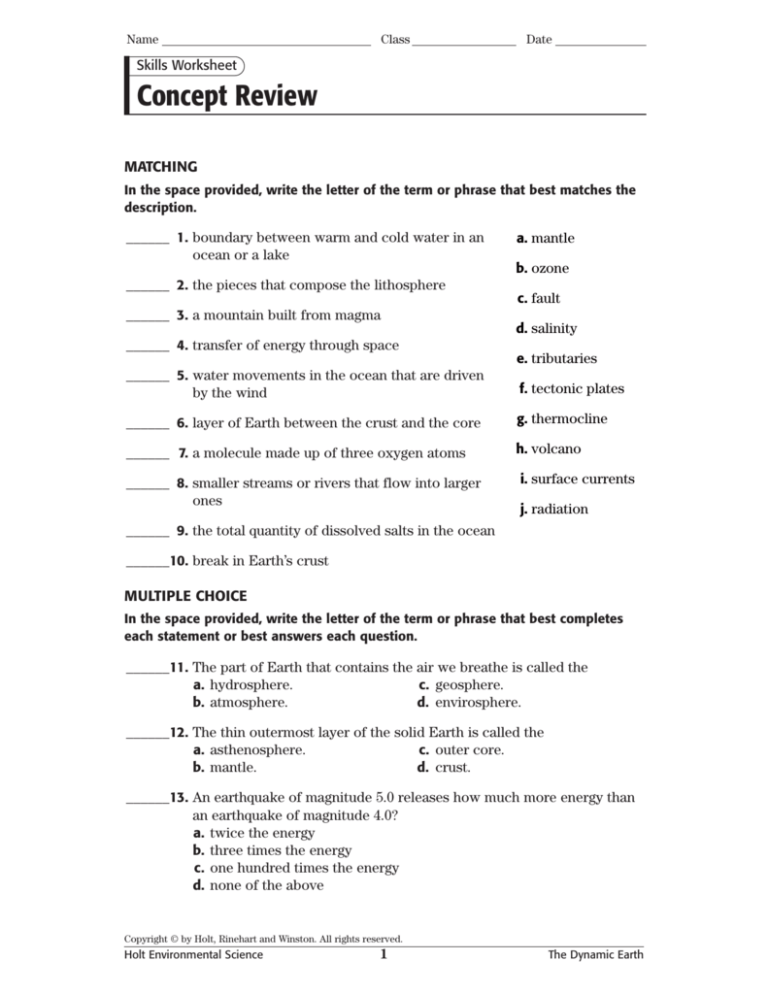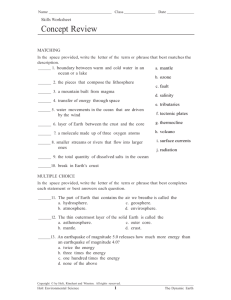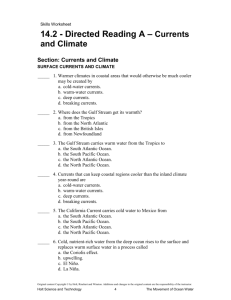
Name
Class
Date
Skills Worksheet
Concept Review
MATCHING
In the space provided, write the letter of the term or phrase that best matches the
description.
______ 1. boundary between warm and cold water in an
ocean or a lake
______ 2. the pieces that compose the lithosphere
______ 3. a mountain built from magma
______ 4. transfer of energy through space
a. mantle
b. ozone
c. fault
d. salinity
e. tributaries
______ 5. water movements in the ocean that are driven
by the wind
f. tectonic plates
______ 6. layer of Earth between the crust and the core
g. thermocline
______ 7. a molecule made up of three oxygen atoms
h. volcano
______ 8. smaller streams or rivers that flow into larger
ones
i. surface currents
j. radiation
______ 9. the total quantity of dissolved salts in the ocean
______10. break in Earth’s crust
MULTIPLE CHOICE
In the space provided, write the letter of the term or phrase that best completes
each statement or best answers each question.
______11. The part of Earth that contains the air we breathe is called the
a. hydrosphere.
c. geosphere.
b. atmosphere.
d. envirosphere.
______12. The thin outermost layer of the solid Earth is called the
a. asthenosphere.
c. outer core.
b. mantle.
d. crust.
______13. An earthquake of magnitude 5.0 releases how much more energy than
an earthquake of magnitude 4.0?
a. twice the energy
b. three times the energy
c. one hundred times the energy
d. none of the above
Copyright © by Holt, Rinehart and Winston. All rights reserved.
Holt Environmental Science
1
The Dynamic Earth
Name
Class
Date
Concept Review continued
______14. Volcanoes occur at tectonic
plate boundaries that are
a. colliding.
b. slipping past one another.
c. separating from one
another.
d. Both (a) and (c)
______20. The warmest temperature
zone of the ocean is the
a. thermocline.
b. deep zone.
c. open ocean.
d. surface zone.
______21. Stream-like movements of
cold, dense water near the
ocean floor are called
a. surface currents.
b. deep currents.
c. bottom currents.
d. mixing currents.
______15. The removal and transport
of surface material by wind
and water is called
a. seismicity.
b. erosion.
c. tectonics.
d. vulcanism.
______22. One of the most important
roles of the ocean is to
a. add oxygen to the atmosphere.
b. trap heat near Earth.
c. regulate temperatures in
Earth’s atmosphere.
d. absorb ultraviolet radiation.
______16. The stratosphere is the
atmospheric layer above the
a. troposphere.
b. ionosphere.
c. mesosphere.
d. thermosphere.
______ 17. Which of the following gases
is an important greenhouse
gas?
a. hydrogen
b. nitrogen
c. carbon dioxide
d. oxygen
______23. The narrow layer of Earth
where life-supporting conditions exist is called the
a. crust.
b. surface zone.
c. troposphere.
d. biosphere.
______18. The most abundant gas in
Earth’s atmosphere is
a. oxygen.
b. carbon dioxide.
c. nitrogen.
d. hydrogen.
______24. With respect to matter,
Earth is mostly
a. an open system.
b. a closed system.
c. an ecosystem.
d. a biosphere.
______19. The transfer of heat by air
currents (or currents in a
liquid) is called
a. radiation.
b. conduction.
c. convection.
d. condensation.
______25. The most important dissolved
elements in ocean water are
a. calcium and magnesium.
b. calcium and potassium.
c. calcium and sodium.
d. sodium and chlorine.
Copyright © by Holt, Rinehart and Winston. All rights reserved.
Holt Environmental Science
2
The Dynamic Earth
TEACHER RESOURCE PAGE
Answer Key
Concept Review
11. The way the east coast of South
America and the west coast of Africa
appear to be able to fit together like
the pieces of a puzzle.
MATCHING
1.
2.
3.
4.
5.
g
f
h
j
i
6.
7.
8.
9.
10.
a
b
e
d
c
AGREE OR DISAGREE
12. Answers may vary. Disagreeing
answers may indicate that cost is prohibitive while earthquakes are actually
unlikely in many areas. Agreeing
answers could state that additional
cost is justified because at least some
of the destruction and loss of life from
earthquakes can be prevented through
good construction techniques.
13. Answers may vary. Disagreeing
answers could suggest that costs to
industry to reduce carbon emissions
would be prohibitive. Agreeing
answers might suggest that the overall cost to the environment of allowing
unchecked carbon dioxide emissions
far exceeds any savings from not
doing anything about it.
14. Answers may vary. Disagreeing
answers might suggest using new
materials from naturally renewable
sources is more efficient than trying to
recover many kinds of used materials.
Agreeing answers could point out that
only through recycling, reuse, and conservation can long-term availability be
ensured.
MULTIPLE CHOICE
11.
12.
13.
14.
15.
16.
17.
18.
b
d
d
d
b
a
c
c
19.
20.
21.
22.
23.
24.
25.
c
d
b
c
d
b
d
Critical Thinking
ANALOGIES
1.
2.
3.
4.
5.
6.
7.
8.
b
d
d
a
b
b
c
c
INTERPRETING OBSERVATIONS
9. Many answers are possible. Credit
should be given for titles that suggest
scientific pursuit of evidence contrary
to prevailing theories and the courage
of Alfred Wegener.
10. A direct answer to this question
simply would be yes. More scientific
evidence is always more likely to be
persuasive in changing accepted scientific theories. In fairness to the scientists of Wegener’s time, the evidence
he did produce may have seemed
unconvincing. However, it could also
be mentioned that scientists are
human and may be significantly
invested in work that is challenged
by the new evidence. This can make
change a difficult process.
REFINING CONCEPTS
15. Answers may vary. Sample answer:
The availability of fresh water can
vary greatly from location to location
because rainfall is not evenly distributed. Desert areas and those affected
by drought can have serious deficits.
Human factors like pollution of watersheds and excessive removal and contamination of groundwater can cause
serious harm to drinking water supplies.
16. Answers may vary. Some possible
responses could mention that human
release of greenhouse gases from
burning of fossil fuels would tend to
warm global temperatures.
Copyright © by Holt, Rinehart and Winston. All rights reserved.
Holt Environmental Science
82
The Dynamic Earth










